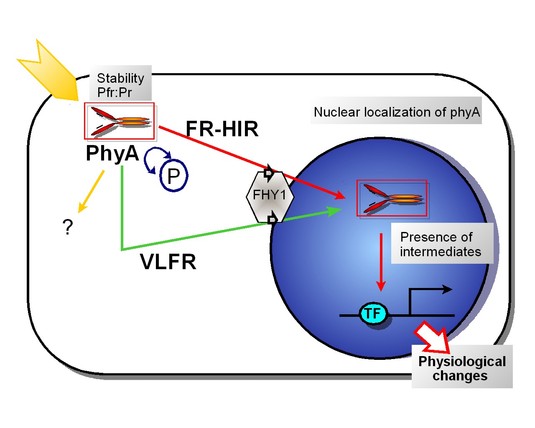Lightsignaltransduction / Photomorphogenesis project
Lightsignaltransduction/Photomorphogenesis
Plants are sessile organisms that depend on light as their source of energy and to instigate adaptation. This can be observed in a variety of light-regulated developmental processes and the ability to adapt to changing environmental conditions. The light-mediated changes in plant growth and development are designated photomorphogenesis.
To monitor variations in wavelength, intensity, direction and duration of light plants have evolved different photoreceptors (”eyes”). Among them the red/far-red absorbing phytochromes are probably the best studied and constitute a family of closely related chromoproteins. In Arabidopsis thaliana the phytochrome family is comprised of five distinct members, phyA - E. Phytochromes exist in two photoconvertible forms, the red light (Pr, 665 nm) and the far-red light (Pfr, 730 nm) absorbing form. These molecular properties allow the phytochromes to sense different R:FR light ratios and to act as light-responsive developmental switches.
The major focus of this project is the genetic dissection of the phytochrome A signal transduction pathway. Phytochrome A is a very special photoreceptor as it is the only one activated by FR light and can both induce high-irradiance reactions (HIR) and very low fluence reactions (VLFR). To elucidate these signaling pathways a combination of physiological, genetic, molecular and biochemical approaches are being employed. The model organism Arabidopsis thaliana allows us to address the following questions:
- How can phytochrome A induce selectively the VLFR or the HIR?
- What are the specific intermediates in these pathways and how do they interact with each other?
- What is the ecological function of the VLFR?
- What is the biological and biochemical role of GRAS proteins such as PAT1 in the light signal transduction?
Which factors interact with PAT1 and its homologous proteins? - How do other signals such as auxin or sugar interact with the light signal transduction?
Coworkers:
Publications:
Kneißl J., Shinomura T., Furuya M., Bolle C. (2008) A rice phytochrome A in Arabidopsis: the role of the N-terminus under red and far-red light. Molecular Plant 1, 1, 84-102
Torres-Galea P., Huang L., Chua N.H., Bolle C. (2006) The GRAS Protein SCL13 is a Positive Regulator of Phytochrome-dependent Red Light Signaling, but can also Modulate Phytochrome A Responses. Mol Genet Genomics 276, 13-30
Seo H. S., Yang J. Y., Ishikawa M., Bolle C., Ballesteros M. L., and Chua N. H. ( 2003) LAF1 ubiquitination by COP1 controls photomorphogenesis and is stimulated by SPA1. Nature 423, 995-999
Zeidler M., Bolle C., and Chua N. H. (2001) The phytochrome A specific signaling component PAT3 is a positive regulator of Arabidopsis photomorphogenesis. Plant Cell Physiol. 42, 1193-1200
Ballesteros M. L., Bolle C., Lois L. M., Moore J. M., Vielle-Calzada J. P., Grossniklaus U., and Chua N. H. (2001) LAF1, a MYB transcription activator for phytochrome A signaling. Genes Dev. 15, 2613-2625
Bolle C., Koncz C., and Chua N. H. (2000) PAT1, a new member of the GRAS family, is involved in phytochrome A signal transduction. Genes Dev. 15, 1269-1278
Halliday K. J., Bolle C., Chua N. H., and Whitelam G. C. (1999) Overexpression of rice phytochrome A partially complements phytochrome B deficiency in Arabidopsis. Planta 207, 401-409


